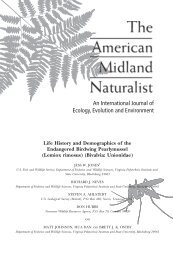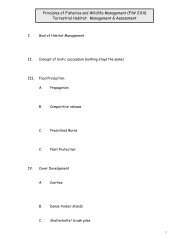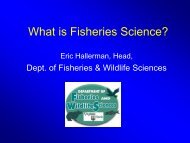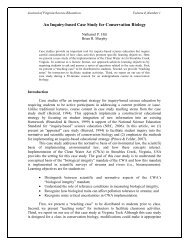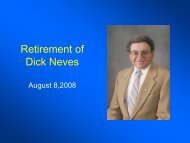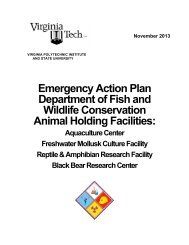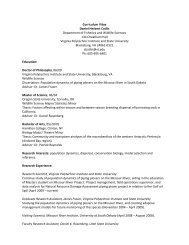Kernel Home Range Estimation for ArcGIS, using VBA - Fish and ...
Kernel Home Range Estimation for ArcGIS, using VBA - Fish and ...
Kernel Home Range Estimation for ArcGIS, using VBA - Fish and ...
You also want an ePaper? Increase the reach of your titles
YUMPU automatically turns print PDFs into web optimized ePapers that Google loves.
ecome more important. The spatial context of animal behavior is important not only in the<br />
management of threatened species that we aim to preserve but also in the management of<br />
threats (e.g. invasive species). With the improvement in our conceptual grasp of home range,<br />
<strong>and</strong> our improvements in home range analysis, the concept of home range has been used <strong>for</strong><br />
habitat evaluation <strong>and</strong> recently, home range theory has even been used to predict fitness<br />
(Mitchell <strong>and</strong> Powell, 2003).<br />
<strong>Home</strong> range theory can be used <strong>for</strong> many conservation <strong>and</strong> management ends. Three things<br />
should dictate the methods used <strong>for</strong> doing this: the objective of the study; the potential of the<br />
data; <strong>and</strong> the life history of the animal. Un<strong>for</strong>tunately, there is no perfect home range estimator,<br />
<strong>and</strong> certainly no estimator should be used indiscriminately of the concerns listed above. <strong>Home</strong><br />
range estimators should not be used as a black box, but should be used as they are intended –<br />
as tools to aid our improved underst<strong>and</strong>ing of animal behavior. The workmanship of the user<br />
rather than the tool will determine the quality of the final product.<br />
This document is intended to give some general background concerning home range theory as<br />
well as to describe one of the tools available <strong>for</strong> home range analysis, ABODE.<br />
2.2. Software discrepancies<br />
What software should I use to analyze home range Larkin <strong>and</strong> Halkin (1994) reviewed several<br />
software packages used in estimating animal home ranges. At that point in time, few options<br />
were available <strong>for</strong> kernel estimation, <strong>and</strong> no comparison was possible. Lawson <strong>and</strong> Rodgers<br />
(1997) made a similar comparison <strong>using</strong> a single real dataset. They found significant differences<br />
between the results from the programs reviewed (CALHOME, RANGES IV, RANGES V, <strong>and</strong><br />
TRACKER). The differences in kernel estimation were attributed to algorithms used in the<br />
programs. For this reason, it is recommended that algorithms be clearly stated in program<br />
documentation. They also noted that there were differences in the options that users were given<br />
in terms of the type of smoothing (fixed <strong>and</strong> adaptive) <strong>and</strong> the actual kernel used in the analysis.<br />
In the time since those publications, several other packages have become available. Most<br />
notably, two extensions <strong>for</strong> ArcView 3x have come into popular use. These are the Animal<br />
Movements Extension to ArcView v2.0 (AMAE)(Hooge <strong>and</strong> Eichenlaub, 2000), <strong>and</strong> the <strong>Home</strong><br />
<strong>Range</strong> Extension (HRE)(Rodgers <strong>and</strong> Carr, 1998). Un<strong>for</strong>tunately no detailed review has been<br />
done <strong>for</strong> these kernel estimators. Several Minimum Convex Polygon (MCP) estimators are<br />
available, but it is hoped that different packages would provide identical results <strong>for</strong> a deterministic<br />
measure such as MCP.<br />
4



